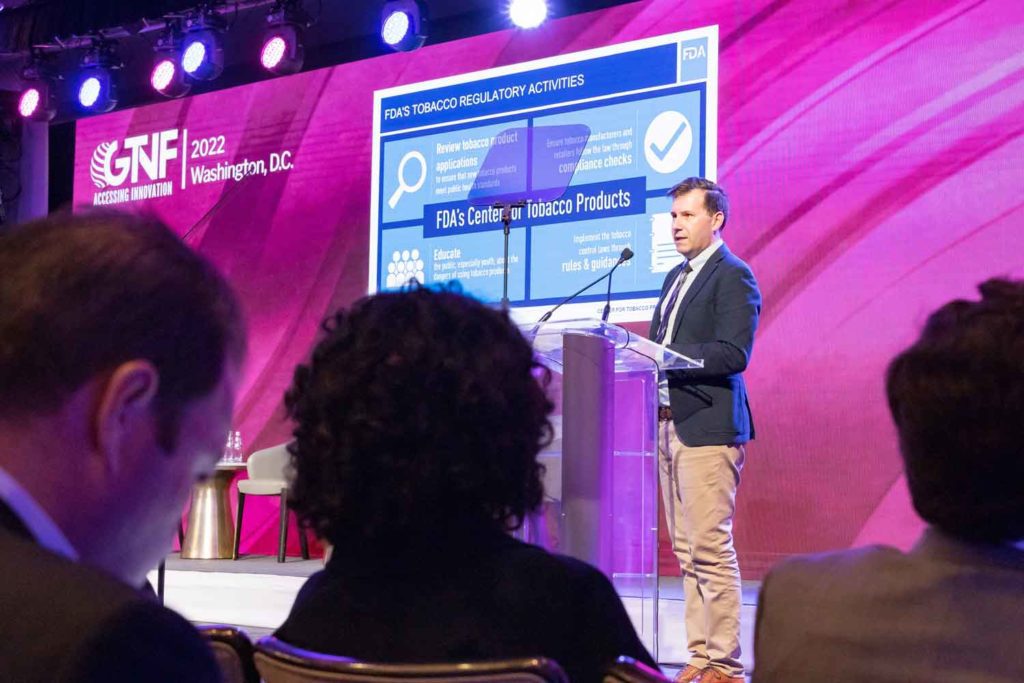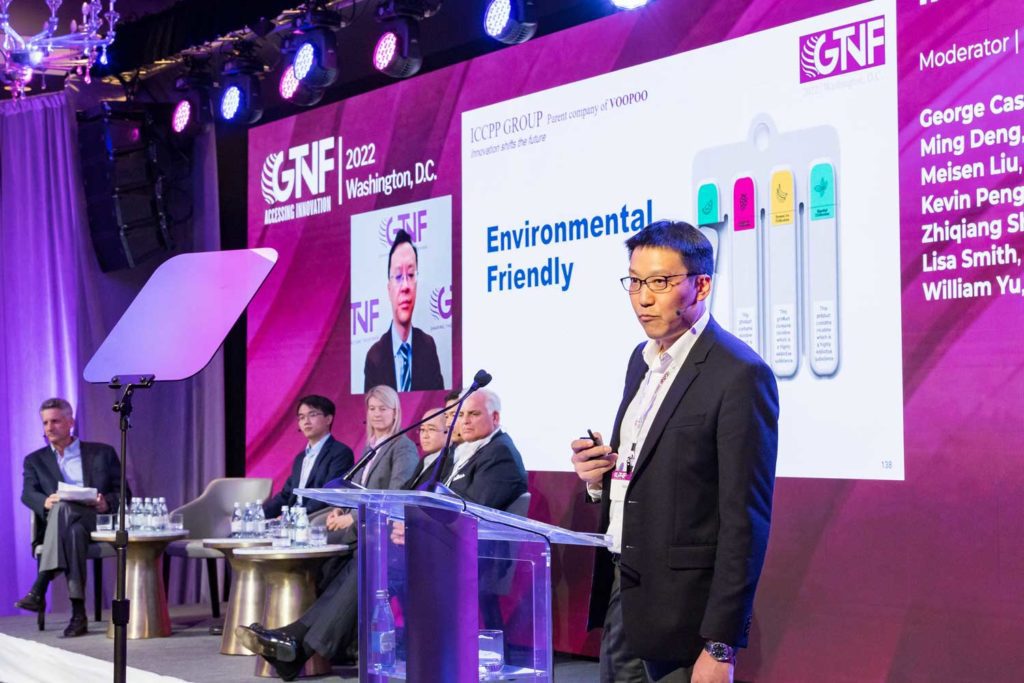
The GTNF 2022 once again delivered on its promise to promote respectful debate among stakeholders in the nicotine business. From Sept. 27 to Sept. 29, participants gathered at the Four Seasons hotel in Washington, D.C., to discuss the challenges and opportunities facing their business, with an emphasis on innovation—and the importance of making the fruits of that innovation accessible to consumers worldwide.
This year’s GTNF was noteworthy for the diverse lineup of participants. More than half of the forum’s participants were not employed by the tobacco industry, and at least 41 percent of speakers addressed the conference for the first time.
Below is a sampling from the conference.

Adam Afriyie: The U.K. Example
Adam Afriyie, Member of Parliament for Windsor and vice chair of the All-Parliamentary Group on Vaping, examined the successful U.K. approach to tobacco harm reduction and the lessons it might hold for other countries.
This was an appropriate time to do so, he insisted, with life returning to a semblance of order following the Covid-19 pandemic and regulators around the world poised to make decisions—“life-and-death decisions”—about alternatives to smoking.
Despite progress, smoking still kills 75,000 people in England yearly. Britain’s National Health Service spends about £2.5 billion ($2.82 billion) annually treating smoking-related illnesses. Every year, tobacco use results in economic losses of £17 billion through ill health, absence and low productivity.
Afriyie distinguished four elements in the U.K. approach, which started with Britain setting a target to make smoking obsolete by 2030.
Second, the government and the health establishment accepted the evidence that vaping and other smoking cessation products, such as patches, pouches and snus, are all part of the legitimate arsenal of weapons against smoking—a conclusion that was reinforced by the Department of Health’s conclusion that vaping is at least 95 percent less risky than smoking. “What matters is the relative harm,” said Afriyie. Rather than relying on conjecture, emotion or the fear of Big Tobacco, the government relied on data, he noted.
Third, the government regulated vaping as a consumer product, setting minimum standards for quality and safety, such as a requirement to sell e-liquids in child-resistant packs. This framework, said Afriyie, allows adults to make informed decisions while protecting children from marketing and harm. All new products must be registered with the Medicines and Healthcare products Regulatory Agency. While vapes are not considered medical products in Britain, this prerequisite installs a discipline among manufacturers to be cognizant of the evidence base behind their offerings, said Afriyie.
Finally, the government commissioned an independent review of the progress toward its smoke-free objective. Published in June, the Javid Kahn report concluded that Britain would miss its target if it continued on the current trajectory. To get the project back on track, Kahn suggested that vaping must be front and center of the drive to eradicate smoking. In light of widespread misperceptions about vaping—50 percent of general practitioners are unaware that vaping is less harmful than smoking—the report also recommended opening a conduit for the industry to communicate directly to smokers the benefits of switching from cigarettes to vapes.
While Afriyie was inspired by the level of technical innovations in nicotine-delivery products, he was less encouraged by the equally important innovation or evolution of regulatory frameworks internationally. For example, while heat-not-burn products have been thriving in Japan, vapes are nearly impossible to access in that country because they are treated as medical products rather than consumer products.
The World Health Organization, too, should adopt the U.K. approach, according to Afriyie. Unfortunately, the global health body’s direction of travel, he said, appears to be made in “smoke-filled” rooms lacking transparency. Rather than basing its policies on science, said Afriyie, the WHO’s stance on tobacco harm reduction products appears to be subject to influences that are not directly to do with public health.
Concluding his presentation, Afriyie addressed each of the stakeholders in the tobacco harm reduction debate. “My message to smokers is please stop. And if you can’t stop, choose a vaping device or a heat-not-burn product—but move on. My message to investors: Britain is open for business.” His comment drew good-natured laughter, but Afriyie was only half joking, reminding his audience that when it comes to smoking cessation products, Britain is a gateway to the world. “The U.K. regulatory imprimatur on your documentation is a sign of quality and an aid to marketing and acceptance around the globe,” he said.
“My message to industry: Be good. Conduct open, honest research,” said Afriyie. “If the answers aren’t exactly what you want, don’t hide the results. Every bit of extra information and knowledge that we gain through research is useful.” To regulators, Afriyie stressed the importance of following the science. “Follow the U.K.,” he said. “Do not let the perfect be the enemy of the good.”

Philip Evans: An Outside Perspective on Innovation
Philip Evans, senior advisor at the Boston Consulting Group, provided an outside perspective on the challenges and opportunities of transformation through innovation.
Evans started by reflecting on the successes and failures of other sectors that, like the tobacco industry today, had faced existential crises. He cited Netflix CEO Reed Hastings’ decision to walk away from the business of distributing DVDs in favor of streaming video, thereby transforming the company and creating staggering amounts of economic value—and contrasted that with BP’s fruitless attempt to rebrand as “Beyond Petroleum.”
What can such experiences teach the tobacco industry about transformation through innovation? Evans identified five lessons.
First, transformation requires a crisis—the more acute, the better. Transformation takes place regularly in the military—always after defeat, when generals are forced to fundamentally rethink their strategies. And one reason the fast-moving tech industry is so innovative is that when a crisis hits, it tends to hit quickly, which means it cannot be evaded.
Second, while companies can try to overcome their problems through mergers and acquisitions, this will not necessarily achieve the type of transformation that the tobacco industry is interested in. Evans cited the example of the American Can Co., a low-margin commodity business that transformed itself into a life insurance company by buying other businesses. “Over time, the only thing that transformed was the business card of the chief executive,” said Evans, adding that “a bunch of investment bankers probably got very rich in the process.”
The third lesson in transformation, according to Evans, is that it almost invariably takes new leaders to set a new direction—and those leaders need a single-minded, long-term vision along with the security and legitimacy to withstand short-term reversals, which is the fourth lesson. Evans notes that successful transformers were often led by a sole proprietor. Bill Gates was able to overcome the threat posed by the internet to Microsoft’s software-based business model in part because he was a uniquely powerful controller and owner of the company.
As the fifth lesson, Evans stressed the importance of a clearly articulated strategy and purpose. “Companies that lose their way cannot recruit good people,” he said. Talented candidates are attracted by the promise of growth and vitality, especially through innovation.
Evans then set out to dispel the myth that big companies are unable to innovate. “It’s untrue,” he said. To illustrate his point, he showed a chart plotting the number of patent filings against the population levels in America’s biggest cities. The cities with the most people clearly filed the most patents. “Innovativeness is a function of the breadth and comprehensiveness of the other ideas to which an individual is exposed,” explained Evans. “That exposure is much greater in a large network than it is in a small one. If appropriately structured, there can be positive economies of scale to innovation; big is indeed beautiful.”
The other secret of cities’ success in innovation is their lack of hierarchies. According to Evans, it’s the hierarchy rather than the scale that squelches the ability of many large organizations to innovate. If a large organization wants to be successful in innovation, it should replicate the hierarchy-free social structure of cities.
To illustrate his point, Evans showed charts revealing patterns of collaboration within Google, Apple and Amazon—companies that are large and innovative. While each of these companies operates in a different part of the innovation cycle, the charts revealed patterns of considerable collaboration.
Openness is key, according to Evans. Google, for example, is deeply networked in academia and does not assert intellectual property in the traditional sense.
This lesson was learned the hard way by the pharmaceutical industry toward the end of the 20th century. In the late 1980s, there was little collaboration among pharmaceutical companies, with each player jealously guarding its intellectual property. When large molecule biotechnology emerged in the early 1990s, many traditional pharmaceutical companies stuck to old models of who owns what—and therefore got marginalized.
In the ensuing decades, they were forced to buy their way back into the business by acquiring some of these biotech companies. According to Evans, the pharmaceutical companies have since learned their lesson. But the point, he noted, is profound: Innovation requires openness and sharing. “It is incompatible with a lot of the traditional ideas about exclusivity, secrecy and ownership,” he noted.

Brian King: Leading an Agency Under Scrutiny
There are plenty of reservations about the way in which the U.S. Food and Drug Administration’s Center for Tobacco Products (CTP) has handled its responsibilities. During a brief speech at the GTNF 2022 in Washington, D.C., the new director of the CTP, Brian King, did little to quell those concerns. He did, however, acknowledge the continuum of risk. “We do have certain products that are lower risk than combustible cigarettes, and that’s an important component of the dialogue,” said King.
King told attendees that there is an opportunity for the CTP to assess the risk of youth vaping initiation and counterbalance that with the opportunity for adults who use e-cigarettes to quit combustible cigarettes.
“I think that [the] public health standard is pretty critical to the work we do, and it’s definitely a guiding light in terms of my determinations and decision-making,” he said. “Ultimately, it comes down to the science … it’s very critical, to me, to ensure that we use that as our guiding light. And, of course, the onus is on the applicants to ensure that they are providing the most robust signs possible to inform decision-making.”
The FDA has long been criticized for its handling of the premarket tobacco product application (PMTA) process and is currently defending multiple lawsuits from vapor companies challenging its marketing denial orders (MDOs), including two from Juul Labs, which recently filed a lawsuit over the regulatory agency’s refusal to disclose documents supporting its MDO.
Juul claims the agency overlooked more than 6,000 pages of the data it submitted on the aerosols that users inhale, according to Joe Murillo, chief regulatory officer at Juul Labs, who also spoke at the conference.
King said that a sizeable portion of youth are still vaping flavored and disposable products. However, he also said that the potential benefits for adult smokers are “mutually exclusive” from youth uptake concerns. “I don’t think that they necessarily have to be separate; they can certainly be explored concurrently,” he said. “But again, we need to ensure that we’re considering the science from both ends when making our decisions.”
King said the agency is “continuing to make progress” on the estimated 1 million PMTAs for nontobacco nicotine products as well. He said over 90 percent of the applications have been completed. “We have 350 acceptances so far, and there’s about 800,000 that have received an RTA [a refuse-to-accept letter], and I’m hopeful that within the next few weeks we should be able to get through all 100 percent of those 1 million.”
Being accepted for review is only the first step in the PMTA process. There are six stages, or rounds, to the PMTA process. After acceptance is filing, then a substantive review before an action is taken. King called the first step an important one. “[It’s] an important step, and I’m committed to ensuring that we keep things moving as expeditiously as possible,” King said.
King recently told the AP that he believes “there’s a lot of really important science and innovations” that have occurred in the vaping industry in recent years, adding that the most notable is nicotine salts in e-liquids. “We know that when you smoke a tobacco product, it’s a very efficient way to deliver nicotine across the blood-brain barrier. So it’s been very difficult to rival that efficiency in another product,” said King in the interview. “But in the case of nicotine salts, you have the potential to more efficiently deliver nicotine, which could hold some public health promise in terms of giving smokers enough nicotine that they would transition [off cigarettes] completely.”
King also discussed the FDA’s ability to force companies to comply with its MDOs. So far, very few companies that have been told to remove their products from the market have complied. King said the agency has multiple enforcement options to bring both manufacturers and retailers to heel.
“We have several tools available to us, including advisory actions,” he said. “We also have regulatory enforcement actions, including voluntary recalls as well as various other requested recalls. We can also take administrative action, civil money penalties (in terms of manufacturers, that penalty cannot exceed $15,000 for any single violation or $1 million for any number of violations related to a single action),” explained King. “When it comes to judicial action, we can do seizure, injunction and also criminal prosecution. I will say that when it comes to enforcement and compliance, nothing is off the table.”
King also updated attendees on the FDA’s external review of the CTP’s procedures, which is being conducted by the Reagan-Udall Foundation. Lauren Silvis, a former FDA chief of staff, was named as chair of the panel that has been asked to “evaluate regulatory processes and agency operations related to tobacco to help the center address new challenges as it works to reduce death and disease from tobacco and achieve its public health mission.”
“Within only a few weeks of assuming this role, we were told that there would be an external evaluation,” said King. “I actually wholly welcome it. I think it’s a good opportunity, particularly with new leadership, to identify areas where we’re doing things very well but also identify areas where we can enhance our efficiency and effectiveness. I have had meetings with [Silvis] and her team, and I’m confident that we’re going to get very useful information.
“It’s an ambitious timeline, 60 business days, so it’s going to work out to about 90 days total. It should finish probably by the end of the year, mid-December, and I’m looking forward to the opportunity to hear the recommendations. And I do have a very open mind on this. I’m always for improvement.”
King expects there will also be opportunities for external engagement, including listening sessions. He could not provide specifics during the speech but said he welcomes feedback from others in terms of informing the CTP’s processes.
“It’s not a one-size-fits-all, but I do think that we have some great opportunities here,” he said. “I’m fully committed to listening to the evaluator’s input and ensuring that we use it in a very useful way … then we’ll take it from there … I’m sure many of you have heard publicly, my calendar is rapidly filling up, and we are meeting with many—I know I’ve met with several of you in the room already, and I value those opportunities to meet with folks from across the spectrum, whether it be industry or public health … to hear people’s insights, what your priorities are.
“And those have been very productive and helpful to me. I do listen. I think it’s a very useful opportunity to me in terms of hearing specifically what the recommendations are from industry and what are areas where you feel it would be useful for FDA to engage in to make your life easier in terms of submissions and applications and [what] processes are overly complicated and could be improved,” said King. “I’m fully committed to ensuring that happens.”

Panel Discussion: The Investment Climate
The 2009 Family Smoking Prevention and Tobacco Control Act charged the U.S. Food and Drug Administration with regulating tobacco products for the protection of public health, so, from one point of view, it was dismaying to hear a panelist on the investor panel of the recent GTNF describe how, under the tutelage of the FDA, the U.S. tobacco and nicotine market had become a resilient one for combustible cigarettes.
Of course, this being an investors panel, the panelist’s comment was less about the FDA and more about Altria, whose short-term fortunes are tied to a large extent to the resilience of the combustible segment and whose reduced-risk strategy was said by another panelist to be unclear. Altria’s appeal as an investment opportunity was contrasted with that of another U.S.-listed company, Philip Morris International, which has had success in moving its sales from higher risk to lower risk products.
The panelists discussed the proposed acquisition of Swedish Match by PMI, which, if it goes ahead, would allow PMI to use SM as a vehicle for marketing in the U.S. the heated-tobacco device IQOS, which has marketing approval and is the subject of an FDA modified-risk order but which is currently banned from being imported following a patents dispute, a ban that is being challenged in the courts. According to one panelist, Altria has an agreement with PMI to market IQOS in the U.S. until April 2024, but there is apparently a question mark over whether the agreement provides for Altria to extend the agreement for another five years.
This raises the question of how an Altria shorn of its right to market IQOS would fare. Well, apparently, Altria is said to be due to unveil a heated-tobacco product toward the end of this year, but with FDA approval necessary, it would take some time for the company to start commercializing a new product. One interesting comment made the point that while PMI was years ahead of Altria in the heated-tobacco product field, the two companies used to be one.
There seemed to be an assumption at times that PMI would easily be able to muscle in on the U.S. market, but not everybody was having that. One panelist made the point that Altria and other U.S. companies were likely to prove highly competitive, and another added that IQOS might not be welcomed with open arms by U.S. consumers who had access to a range of reduced-risk products, including e-cigarettes, which had out-competed IQOS on some other markets. But on the other side of this coin, PMI was said to be starting to widen the focus of its reduced-risk strategy in respect of product categories.
It would seem that a week is a long time in the investment arena. During the panel discussion, Altria was seen as being in a difficult position when it comes to vaping. Its investment in Juul Labs involved a no-competition clause, and Juul has suffered a setback in the form of an FDA marketing denial order (MDO). The panelists indicated that the MDO was being contested, however, and that it would be open to Altria to make an outright bid for Juul. Less than a week after the panel met, however, Altria announced that it had exercised its option to permanently terminate its noncompetition obligations to Juul.
Surprisingly, perhaps, threats raised by the potential cigarette menthol ban and the imposition of a very low-nicotine cigarette standard in the U.S. were not yet seen as particular drags on tobacco businesses’ appeal to investors since, partly because of likely legal challenges, they were seen as being some way off.
On a wider front, while PMI was seen as a growth company, it was said to be facing headwinds created by the strength of the dollar and its exit from Russia. Or not. One panelist said that only Imperial Brands had exited Russia completely and that he would be surprised if the other major companies, which had invested heavily in the country, had exited Russia without providing for a way back.
On a more general level, the investment case for tobacco was seen as strong, partly because most companies—the exception seems to be PMI—are undervalued but also because they offer strong and secure cash flows and high yields. This situation was said not to have changed but to be more appreciated now than it was two or three years ago, particularly in the face of a recession. And while the appeal of tobacco stocks would be negatively impacted by the current increases in interest rates, on the positive side, most tobacco company debt was at fixed rates. Still, environmental, social and governance issues comprised an overhang in respect of getting investors interested in tobacco stock.
The discussions were heavily skewed toward the U.S. market and U.S. companies to the extent that the chairman apologized for ignoring the world outside the U.S. and Europe. The upcoming EU directives on excise taxes and tobacco products were mentioned, the former in a fairly good light given that it seemed that harmonized taxes would not be set at the same level across product categories but at a lower level on less risky products. Such a rational policy seems at odds with the Tobacco Products Directive, which seems set to retain the irrational ban on snus.
BAT and Imperial Brands were said to be undervalued by investors. BAT’s multi-category reduced-risk portfolio was held up as the way ahead, and its success with Vuse was highlighted a couple of times. Mention was made of a new management at Imperial that was said to be getting to grips with the business, focusing on the areas where it could perform well, resetting its new-generation products business and creating an opportunity for some geographical divestments.

Panel Discussion: Global Regulatory Issues
It’s been almost 60 years since a U.S. Surgeon General first stated the dangers of cigarette smoking and 50 years since scientists found out that the inhalation of smoke rather than nicotine is the major cause of smokers’ health problems. With goals in tobacco harm reduction (THR) long set, regulators should be able to solve the problem and shape rational regulation, argued moderator David Sweanor, adjunct professor of law at the University of Ottawa. “In all cases, it’s only small steps forward. What would happen if we saw this as a matter of urgency and, for instance, allow more products at a time?”
Gizelle Baker, vice president of global scientific engagement at Philip Morris International, stressed the role of science as a basis for policymaking. “Science isn’t perfect, but it has evolved,” she said. “We need to look at the data we need in the future to correct our idea and come to conclusions that can drive policy. Because the only way to shape policy is to use science, data and facts.” Knowledge about long-term effects or which part of the population in certain countries will use a reduced-risk product (RRP) can only be gained if the products are put on the market, she stated.
Konstantinos Farsalinos, research fellow at Onassis Cardiac Surgery Center, noted that there are no missing data, only missing common sense. “We will never be fully informed about anything,” he said. “At one point, we have to make a decision.” The bar of proof for THR has been set extremely high, Farsalinos noted. In some markets, this forces smaller companies to leave the market to big companies that can afford the approval process. “We live in a high-risk society—let’s consider THR like any other harm reduction strategies,” he said.
Marewa Glover, director of the Center of Research Excellence on Indigenous Sovereignty and Smoking, spoke about New Zealand’s Smoke-Free Aotearoa 2025 Action Plan, which is currently under review and includes a smoking ban for all those born after 2008, a drastic reduction of legal retail outlets for RRPs and the reduction of nicotine content in combustible cigarettes to nonaddictive levels. Glover said the draft bill lacks not only common sense but also compassion. “The regulatory intent is to not allow vaping to become normalized but denicotinization,” she said. “As a smoker, you should switch to vaping temporarily and then quit completely. Anyone who quits vaping should never go back.” She predicted a domino effect on other countries and urged regulators not to follow the example of New Zealand.
The objective of THR, said Sharon Goodall, group head of regulatory science at BAT, is very clear: to reduce the number of smoking-related deaths. The sentiment of positivity that comes with this prospect should be maintained in the industry’s talks with regulators who are willing to change their approach toward THR. “We must not get distracted. We must react to individual events but remain focused on the long-term outcome. There are insufficiencies in the system, markets without open dialogue, therefore we must continue to work with regulators.”
Focusing on the role of market structure and competition in the U.S., David Levy, professor of oncology at Georgetown University, pointed out that before 2005, the cigarette industry was static and homogeneous and, for tobacco control, the epitomized enemy. After 2005, the market fragmented, with consumers using multiple products. After 2012, e-cigarettes quickly gained market share.
Tobacco companies responded by producing their own e-cigarettes. They played a role but didn’t control the market. Vaping became a highly competitive market. Recently, it has been joined by heated-tobacco products, which, Levy said, could play an important role as they solved problems e-cigarettes couldn’t solve. “Companies have to be serious in THR because it’s decisive for their businesses,” he said. “New Zealand and the U.K. have done well in THR. In low[-income] and middle-income countries [LMICs], such as India or Pakistan, oral nicotine could replace the highly harmful chewing tobaccos. However, restrictive policies, such as a ban of RRPs, will drive smokers back to cigarettes.” Levy saw clues for a closer cooperation between the industry and public health.
Fadi Maayta, president and co-founder of Alternative Nicotine Delivery Solutions, provided a snapshot of the situation in LMICs by portraying the Middle East and North Africa (MENA) region, which he called a forgotten region in the picture of THR.
Of the 547 million who live in the region, there are 140 million adult smokers. In some countries like Jordan, there is a smoking incidence of more than 60 percent, and cigarette sales are growing across the region. Governments are employing the typical measures to curb consumption, such as tax hikes and increases in customs. Saudi Arabia was the region’s only country to introduce plain packaging, which resulted in a burgeoning illicit cigarette market.
Eight out of the 22 MENA markets have regulated vape products whereas the remaining 14 have banned them altogether. In these markets, however, vape products are still around—and unregulated. But even in regulated markets, 80 percent to 90 percent of the markets are illicit products because the government followed an aggressive path when regulating the products, introducing a fiscal and regulatory framework that is stricter than that for cigarettes.
“Throughout the region, misinformation is polluting the whole idea of THR,” said Maayta. “Regulators rely on articles about the harm of e-cigarettes, instead [of] on robust science, and still believe that nicotine causes cancer.” An opportunity, he said, could be to cooperate with global THR associations.

Plenary Panel: Innovating for Tomorrow
When creating a smoke-free world, innovation must take place not only in terms of products but also in terms of regulation, communication and sustainability. That was one of the messages of the “Innovating for Tomorrow” panel discussion during the recent GTNF in Washington, D.C.
Ming Deng, head of the Next-Generation Products (NGPs) Industry Study at Yunnan University, spoke about his desire to make NGPs smart and mobile. At present, he said, the electronic functions that differentiate an NGP from a combustible cigarette just serve as a marketing tool. However, the Artificial Intelligence of Things (AIoT)—the combination of artificial intelligence and the Internet of Things—offers considerable opportunity to improve human-machine interactions and enhance data management and analytics, among other benefits. “With AIoT, producers could trace consumers’ needs and innovate products accordingly,” said Deng.
For Meisen Liu, R&D director at Shenzhen Zinwi Bio-Tech, lower temperature atomization is one of the most important objectives in current research as it is safer for human health. A higher atomization temperature causes atomizing agents to decompose into harmful aldehydes whereas atomizing agents with a low boiling point decrease the atomizing temperature and reduce the emission of harmful substances. Liu also described how nicotine salts derived from different acids had different properties regarding sensory stimulation or taste. His company, he said, had created a new type of nicotine salt that allows for enhanced stimulation in markets where the amount of nicotine in e-liquids is restricted.
Kevin Peng, advanced technology scientist at ALD Group, spoke about technologies to reduce the carbon footprint of vape product manufacturing and consumption. Earlier this year, his company launched a “green cigarette,” a disposable vape product featuring 6 percent lower carbon emissions than combustible cigarettes. The company also developed a super-slim pod for reusable vaping devices made from a material that has only one-third of the carbon emission of ALD’s older materials. This way, he said, his company had achieved a 50 percent emission reduction compared to other pod products.
ALD also conducted an emission assessment for its organization and products. “ESG [environmental, social and governance] is a much more difficult thing than we thought,” Peng stated. “We found that most suppliers are not very responsive in terms of such requirements.” He called for a unified industry ESG standard for suppliers, which would make it easier to reduce emissions.
To help accelerate its transformation, BAT established Btomorrow Ventures two-and-a-half years ago. Lisa Smith, the subsidiary’s managing director, related how Btomorrow had set up a number of innovative ecosystems. “It’s a highly competitive market,” she said. “It’s difficult to find the best innovators out there.” Her company’s role is to be the “handshake” to the outside world to show that BAT is an appropriate partner for innovators. Among the many tasks in BAT’s transformation are to quickly promote the ESG agenda and move beyond nicotine. In order to achieve the latter, she said, the company had to build science and credibility.
ICCPP, a provider of solutions for e-cigarettes and heated-tobacco products, believes that the key to innovation in vaporization might be the ceramic coil. The company, which focuses on research and manufacture of electronic atomizing technologies and is the parent company of the Voopoo vaping brand, introduced the world’s first nano-microcrystalline ceramic core in 2021. According to William Yu, vice president of global ODM business at ICCPP, the core is based on environmentally friendly mineral materials that result in an increased nicotine delivery and stable flavors. In combination with a powder-free technology and a porous structure, the core enables a significant increase in atomization, according to Yu. The company also develops environmentally friendly products, such as a disposable cigarette made from special recyclable paper.
Continuing to innovate is essential as the industry is at a crossroads, said George Cassels-Smith, CEO of Tobacco Technology Inc. (TTI). After the Food and Drug Administration, through its onerous market authorization processes, had “frozen” the U.S. market for next-generation products, TTI opened a new manufacturing site in Italy, which according to Cassels-Smith is more open to innovation. “It’s vital to involve science, which is one of the pillars of what is a quick-moving new technology,” he said. “It needs expertise to focus on this direction because, ultimately, we must find superior products to combustible cigarettes.”












